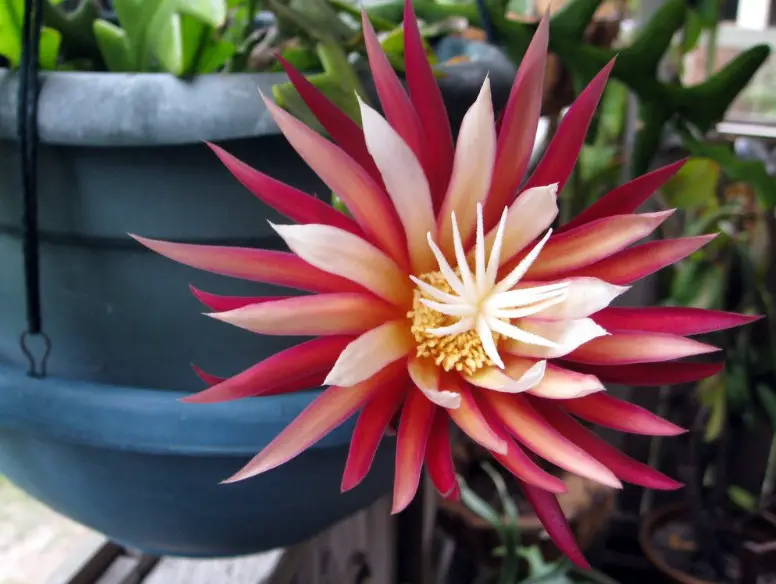The Ric Rac Cactus, scientifically known as Selenicereus anthonyanus, is a succulent renowned for its intricate, wavy stems reminiscent of fishbones. Its unique appearance and relatively low maintenance make it a popular choice among plant enthusiasts.
In this comprehensive guide, we will delve into the detailed care and growing techniques required to cultivate a thriving Ric Rac Cactus.
About Ric Rac Cactus

Ric Rac Cactus, also known as Fishbone Cactus or Zig Zag Cactus, scientifically named Selenicereus Anthonynaus, belongs to the Cactaceae family. Native to Southern Mexico, this succulent boasts a medium growth rate, making it an ideal addition to any indoor garden or desert landscape.
Characterized by its unique appearance, the Ric Rac Cactus features green waved stems that closely resemble fishbones, adding an intriguing aesthetic to any space. Typically reaching heights of up to 2 feet tall, it thrives in well-draining cacti-suited soil.
When it comes to care, the Ric Rac Cactus prefers to be watered when the top inch of soil is dry, ensuring proper moisture without risking root rot. It thrives in temperatures ranging from 65 to 85 degrees Fahrenheit and requires bright indirect sunlight for optimal growth.
One of the notable features of this cactus is its non-toxic nature, making it safe to keep around both cats and dogs, as well as humans. However, like many plants, it is not immune to pests such as mealybugs, scale, and aphids. Additionally, vigilance against diseases like root rot is essential for maintaining the health and vibrancy of this striking plant.
With its striking appearance and relatively low maintenance requirements, the Ric Rac Cactus is a popular choice among succulent enthusiasts and adds a touch of natural beauty to any indoor or outdoor space.
Ric Rac Cactus Identification
The characteristic waving stems of the Ric Rac Cactus resemble fishbones, which sets it apart. Its overall visual appeal is enhanced by these trailing stems, which give the plant a lush, green appearance. The plant is notable for its night blooms, which are fragrant and vary in color from white to pale yellow. Under ideal circumstances, these blooms begin to blossom in the fall and eventually give way to gooseberry-flavored edible green fruits.
Ric Rac Cactus Care

Understanding the Ric Rac Cactus’s tropical origins is essential to providing it with proper care. This species does not do well in dry climates; instead, it prefers habitats with higher humidity and some shade. Its natural environment is mimicked by consistent irrigation and the use of well-draining soil that has been enhanced with organic materials.
Fertilization helps during the growing season and encourages strong growth. Its sprawling tendency can also be supported with a supporting structure, which will assist keep the plant attractive and healthy. The Ric Rac Cactus is particularly well-known for its fragrant, night-blooming flowers, which are normally pollinated by bats in their natural habitat. Enthusiasts can stimulate the appearance of these captivating blossoms by using appropriate gardening techniques.
Light
The Ric Rac Cactus has specific requirements when it comes to lighting. It thrives in bright but indirect light, benefiting from exposure to ample sunlight without direct harsh rays. Shielding it from the intense afternoon sun is crucial to prevent the leaves from scorching, maintaining the plant’s health and appearance.
For optimal growth, consider placing the Ric Rac Cactus near a north or east-facing window where it can receive sufficient natural light without being exposed to direct sunlight for extended periods. This positioning ensures that the plant gets the light it needs while minimizing the risk of sun damage.
Soil
When it comes to soil requirements, the Ric Rac Cactus thrives in a specific environment that promotes healthy root growth and overall plant vitality. It is recommended to plant the Ric Rac Cactus in a well-draining soil mix that is rich in organic matter.
Creating the ideal substrate involves a blend of potting soil, perlite, and orchid bark. This combination ensures proper drainage, preventing waterlogged conditions that can lead to root rot. The potting soil provides essential nutrients for the plant’s growth, while perlite enhances aeration and drainage. Additionally, the inclusion of orchid bark adds further drainage capacity and contributes to the overall texture of the soil mix.
By planting the Ric Rac Cactus in such a soil blend, enthusiasts can mimic its natural habitat and provide the optimal conditions for healthy growth. This tailored soil mix promotes root development, reduces the risk of moisture-related issues, and sets the stage for a thriving and vibrant Ric Rac Cactus in any indoor or outdoor setting.
Water
Proper watering is key to the health and well-being of the Ric Rac Cactus. It’s advised to water the Ric Rac Cactus when the top layer of soil has dried out completely. During the growing season, which typically spans spring and summer, regular watering is crucial to support its active growth and development.
However, it’s important to adjust the watering regimen during the dormant winter months. As the plant’s growth slows down during this period, watering should be reduced to prevent overwatering, which can lead to root rot and other moisture-related issues.
Temperature And Humidity
The Ric Rac Cactus demonstrates optimal growth and vitality within a specific temperature and humidity range. It thrives in temperatures ranging from 60 to 75°F (15 to 24°C), providing an ideal environment for its development. Maintaining temperatures within this range ensures that the plant remains comfortable and can carry out its physiological processes efficiently.
In addition to temperature considerations, higher humidity levels are beneficial for the Ric Rac Cactus. Elevated humidity mimics its native tropical environment and supports its overall health. Enthusiasts can achieve increased humidity levels by employing methods such as misting the plant regularly or utilizing a humidifier in the surrounding area. These measures help create a more favorable microclimate for the Ric Rac Cactus, promoting robust growth and vibrant foliage.
Fertilizer
To ensure optimal growth and health, it’s essential to fertilize the Ric Rac Cactus appropriately. During the active growing season, which typically spans from spring through summer, feeding the plant with a balanced liquid fertilizer is recommended.
A diluted fertilizer solution should be applied approximately every 4 weeks to provide the necessary nutrients without risking over-fertilization. This feeding regimen supports the Ric Rac Cactus’s growth and development, ensuring it receives the essential elements required for thriving.
Pruning Ric Rac Cactus
Pruning the Ric Rac Cactus is typically an infrequent task, as the plant naturally maintains its shape well. However, occasional pruning may be necessary to ensure its continued health and aesthetics. Removing dead or damaged stems not only improves the plant’s appearance but also prevents potential issues from spreading.
To prune the Ric Rac Cactus, use clean and sharp scissors or pruning shears. Trim away any dead or damaged stems carefully, making clean cuts to minimize the risk of introducing pathogens. Additionally, pruning can encourage new growth and rejuvenate the plant, promoting its overall vigor.
Propagating Ric Rac Cactus
Propagating the Ric Rac Cactus through stem cuttings is a straightforward and rewarding process. To begin, select a healthy stem and carefully cut it from the parent plant using clean, sharp scissors or pruning shears. Allow the cutting to air dry in a shaded area for a day or two to promote callusing and reduce the risk of rotting.
Once the cutting has dried, prepare a suitable soil mix for planting. A well-draining blend, such as a combination of potting soil, perlite, and orchid bark, works well for rooting cuttings. Plant the cutting into the soil mix, ensuring that it is positioned upright and the bottom end is buried slightly to encourage root formation.
Place the planted cutting in a location with bright but indirect light, avoiding direct sunlight, which can cause stress or scorching. Keep the soil lightly moist but not waterlogged, as excessive moisture can lead to rotting.
With proper care and attention, the Ric Rac Cactus cutting should begin to develop roots within a few weeks. Once roots have established, gradually acclimate the new plant to its growing conditions, and continue to care for it as you would for a mature Ric Rac Cactus.
Pests and disease problems
The Ric Rac Cactus, like many plants, is susceptible to certain pests and diseases that can affect its health and appearance. Two common issues to watch out for are mealybugs and root rot.
Mealybugs are small, white, cottony insects that often gather on the stems and leaves of plants, including the Ric Rac Cactus. If left untreated, they can cause damage and weaken the plant. Fortunately, infestations can be effectively treated with insecticidal soap or neem oil. These solutions help to suffocate and eliminate the mealybugs while being gentle on the plant.
Another potential concern for the Ric Rac Cactus is root rot, typically caused by overwatering and poor drainage. Soggy soil conditions create an environment where fungi thrive and attack the roots, leading to rot. To prevent root rot, it’s essential to ensure proper drainage in the soil and avoid letting the plant sit in waterlogged conditions. Using a well-draining soil mix and watering only when the top layer of soil is dry can help mitigate this risk.
Ric Rac Cactus Common Issues

Common problems encountered with Ric Rac Cactus include drooping stems, failure to bloom, and yellowing leaves. Drooping stems are typically a sign of overwatering, where the soil becomes waterlogged, leading to root rot and weakened stems. To address this issue, it’s crucial to check the moisture level of the soil regularly and adjust watering habits accordingly, allowing the soil to dry out between waterings.
Failure to bloom can result from various factors, including insufficient light or improper care. Ric Rac Cactus requires bright but indirect sunlight to produce flowers successfully. Reviewing care practices such as watering, fertilization, and light exposure can help identify and rectify any issues hindering blooming.
Yellowing leaves may indicate a nutrient deficiency or overwatering. Assessing the soil condition and the plant’s feeding routine can help determine the underlying cause. Adjusting the fertilizer application or addressing any drainage issues in the soil can help correct the problem and restore the health of the Ric Rac Cactus.






